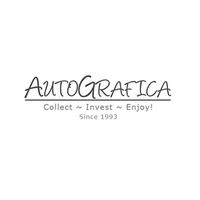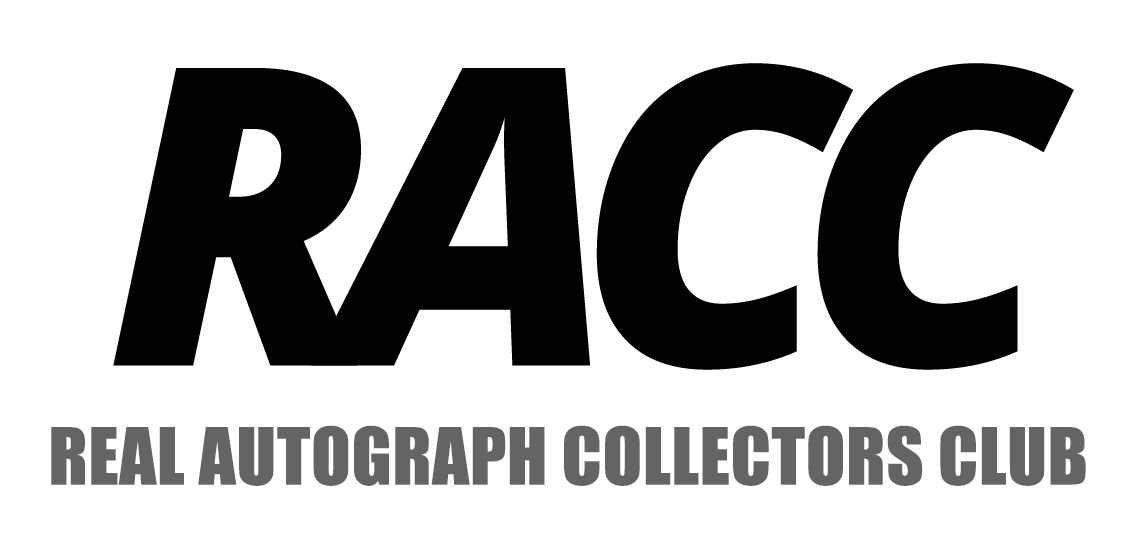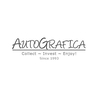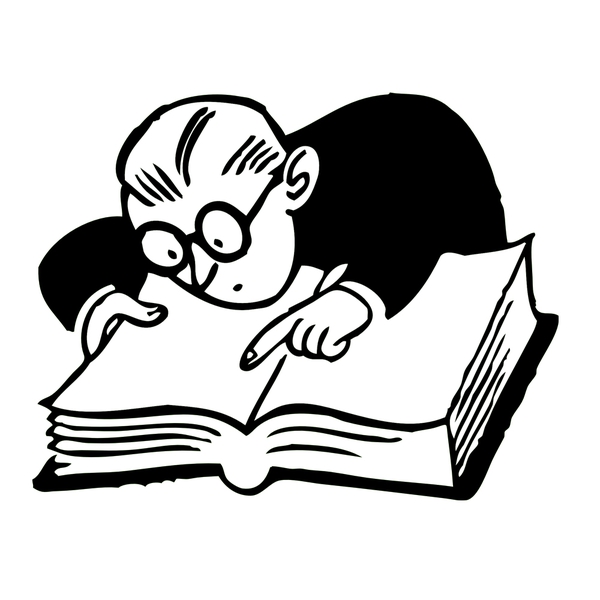Autografica
- Home /
- Autografica /
- Blog
Autograph terminology
You will see many different terms used by various dealers around the world, much of it is self explanatory, so we won't go into those here, but some of the terminology used needs a little explanation, and i think you should give some thought as to how and why some dealers might use these terms.
I hope it fair to say that most dealers will agree with the way that i have outlined these terms. I know that some will disagree on certain points, but i truly believe that the way i have laid them out here is the way the words should or should not be used, because when used in the wrong manner, all they do is mis-describe what is being sold, and can therefore be misleading.
So here then are my versions of the terms we all see being used, and the meanings that some dealers might mean them to be! This list will be added to as time goes by, but here are a good few to be going on with.
What do we mean we we say 'in person signature'? This is a term that we often see being used by many dealers both good and bad, and is meant to describe an item whereby the signature was obtained in person. But what exactly does this mean?
In our case, if it ever states that an item was obtained by me in person, it means exactly that. I myslef, not someone who works for me, obtained the signature directly from that person who signed it right there in front of me. It does not mean that i bought it from someone else who tells me that they obtained it themselves in person 5 years ago. It might sometimes mean that i was standing next to the person who was working for me when he got it signed, but either way it would mean that i was there and i saw it signed with my own eyes.
I cannot see how a item can be described as 'in person' when the item was signed years before for someone else and you were not there. I do understand that it could be described as being obtained 'in person' by someone else, but then it should be described as such, and not offered as an 'in person' signed photo when the person selling the photo did neither obtain it themselves or was there when it was signed.
Beware of the many sellers on ebay who describe everything they have as obtained 'in person' as this is simply another way to make you think that the item is real, when it is a simple forgery. Indeed, the most annoying question that any dealer gets asked is 'when and where was this item signed?' Now as a dealer who offers a broad sprectrum of signed items, i cannot possibly tell you where every item was signed, as some of those names may have been dead a hundred years or more!
If you were considering buying an Elvis Presley signature, would you expect the seller to know when and where it was signed? no of course not. It may well be that the seller was the person who obtained that very signature, but it is unlikley. But this kind of question just allows you to fall into the hands of the forger, as he will simply tell you what you want to hear, making you feel more asured, which could result in you making a purchase! Aways remember that a forger is a liar, and a liar a very possible forger! So if he is prepared to lie about when or where an item was signed, then he is certainly willing to create a nice looking COA and a great story to go with the fake signature, so beware.
What is a 'cut' signature? This is a term that has now become common over here but we think came from the USA, but is a term you certainly won't hear us using because it is now very much associated with fake autographs!
I believe the term has been in use for many years to describe a signature on a piece of paper that has been 'cut' from the bottom of a letter or document. Unfortunatly the term has been hijacked by a group of forgers exposed by the FBi in around 2000 during Operation Bullpen (Google it!). These forgers simply obtained stacks of old books from charity shops etc, then cut out the blank pages and then added fake signatures to them. Because the paper was old, this created the impression that the whole signature was of the right period, and thus made it easier to sell. During the FBI raids, which happened at dozens of shops right across the USA, the FBI found thousands of 'cut' signatures. These pieces of paper contained just about every name that was of any real value to a collector, but all were fake!
But, during the period since 2000 you will notice that there have been more 'cut' signatures around than there are signatures on album pages. As any dealer or collector will tell you, you will find most signatures are on proper album pages and not neatly cut pieces of paper. You can normaly spot these fake 'cuts' as they will be on paper that has been taken from an old book, and this will normaly be of a lower quailty paper than modern books or printing paper, and will often have started to go brown, often only down one side, which would be the edge of the paper. So if you are offered any signatures that appear to be on old paper, but looks like it could have come from a book, our advice is to stay away!
If you ever attend one of our courses, we tell an amusing story about a collector who came to us with a collection of 'cut' signatures he had bought from a US dealer. We were able to tell him they were fake, without even looking at the signatures! but can you work out how?
What is a COA? Certificate of Authenticity? Sometimes also called a Letter of Authenticity or LOA. First, let us just say that any dealer worth his salt will tell you that any COA is only as good as the seller, and if the seller is bad, then your COA is worthless, so do not ever rely soley on a COA as your proof that an item is authentic. A COA does not make an item authentic. An item is either real or its not, and no amount of fancy COA, 'provenance' or anything else will make a fake signature real.
If a seller states that the COA proves that the item is authentic then in my opinion you should avoid that seller, as no COA can prove any item to be authentic. There have been many cases we have been involved in via Trading Standards where the seller issues COA's etc, but they are lying, here is one recent example.
Always read any COA carefully, does it have the sellers full geographical contact details on it? are they correct? Phone number? or does it simply have an ebay ID and an email address? Does it have any limitations on term? 28 days? 1 year? or is it a lifetime?
Your own common sense should tell you that it should have the sellers full name and address details and make it clear that the item is guaranteed genuine for life with no limitations.
What is a Private Signing? What this should mean is that the seller has procured the services of a person, normaly for a fee, and has then sat down with them 'in private' and they have then signed an agreed number of items for that seller. It does not mean being the only one at a stage door so you got a few more items signed than you may have hoped for, nor does it mean that you queued up with 200 other people to get your stuff signed at a convention or other public signing!
We have done a number of private signings with various people, and they have always been exactly that, a private signing, normaly at their home or possibly a hotel, whereby that person has signed our items just for us and normaly for a fee. And if anyone suggests that the items were obained via a private signing, then they should have the photos from that signing to prove it!
When does Rare mean Rare? This is a word that most dealers rarely use except in the true case whereby an item is indeed rare!
A signature can indeed be rare, or the signature could be on an unusual item, but that does not then make it valuable, so rare and valuable do not always go together! Beware of those sellers that use the word in every description as this tells me that they probably know very little about autographs and are simply using the word to big up their own items. You can read more about an autographs rarity and value here.
What is a Photograph? How many times have you bought a 'signed photo' only to find out that it is in fact an image produced on an inkjet printer? I know i have and put simply it is not just annoying its misrepresenting the item to gain a monetary advantage, in other words...fraud!
A photograph is defined as "a photograph or photo is an image created by light falling on a light-sensitive surface, usually photographic film" so it does not mean lots of splashes of ink thrown onto a piece of thick paper by an epson printer!
Today most images are digital and are produced in a slightly different manner to the old 'wet' system, but they are still a long way away from an ink jet picture, and even on inspection by an expert are very hard to tell from the old real photographic process, but they can certainly still be considered as a Photograph.
The other 'photo' that we are often offered is the image that has been simply cut from a book. These are in most cases printed on a machine using thousands of tiny dots, and its those dots that sometimes make it almost impossible for you to scan the image, as the dots interfere with the DPI (dots per inch) that your scanner is trying to use to copy the image, and that is why you get those strange patterns when scanning (moiré effect).
If you collect space signed items, you will often see these items offered refered to as 'lithos' because they are produced by the lithographic printing process. But what they are not is a photo! If you can see little dots all over the image, then its not a photograph, unless of course its a photograph of a litho!
In autograph terms, what does Provenance mean? This is often misspelt as 'providence' or similar by some, but the word in our case must mean 'the provable history of the item' in other words some paperwork or documentation that helps to prove any story attached. This could be a series of invoices from various known and trusted dealers or auction houses, or perhaps a letter from the original person who obtained the item outlining the exact circumstances the item was signed. What it is not is simply a story told to you by the seller of who the items was signed! In my experience these 'stories' are exactly that, just a story, albeit one that may have some substance of truth, but a story nonetheless. For instance i am offered Beatles autographs on a regular basis, some are secretarial, but most fake but still come with the most superb story as to how they were obtained, which when checked out, are accurate and could certainly be true. But all that has happened is that the seller has faked the signatures (or bought them from someone who has!) and then made up a great story to go with them by simply checking through one of the many books that will tell you where the Beatles where just about any day during their life. The same can be done for almost anyone today with a quick search on the internet, you can even find images of anyone signing something to go with it. Here is an example of a crook who has received a jail sentance for just such a crime.
What is a secretarial signature? Very simply, these are signatures which have been done by a secretary of someone famous with their permission. These are fairly common, and more so now than they were 10 or 15 years ago before the advent of internet auctions and 'dealers' who make a living by selling items they have obtained by writing to famous people (often called TTM - Through The Mail).
These signatures can be very tough to spot and often even the best dealers are not aware of the problem until long after the celebrity has died and their secretary admits the deceit! Charlton Heston is one such example. He was well known as a very good signer in person as he would always take time to sign for everyone when asked. He was also known as a good signer by mail as well. But when he died his long time secretary admitted that in fact she signed most of his mail, all except that is his books, which he would normally sign himself. Because she spent time every day signing his signature on items, and because he then spent time signing his books, it was almost impossible to spot the difference. Today we all know what to look for to be able to tell the difference between the two, but many dealers were caught out on this one, myslef included!
There are many very good examples of secretarial signatures that can still fool dealers and collectors today, one of the most well known are the Neil Aspinal Beatle sets. Neil was their road manager and later head of Apple, and during those early years he would sign many of the items given to him by fans for signing backstage, and at stage doors etc.
If you look on ebay you will find many examples of A list celebrity signed items that have been obtained TTM. although the sellers do not normally tell you this! They will suggest that they obtain their items directly from the star, or travel the country searching them out to get items signed. In reality, they are simply using a myriad of friends and relatives address's to obtain multiple signed items through the post. There are a number of websites that will even give you the address of a celebrity. all you need is a a pen, a SAE, and some photos and you are in business! But do you really think that the A list celeb that you write to has the time to read and sign your items? when they have a life of their own to live and a touring, filming or recording schedule that keeps them away from home 6 days a week? Exactly, they get someone else to sign them, so beware!
What is a 'Club House' signature? This is realy an American term, that i am sure will find its way over here eventually. It refers to items signed by other players within a team, rather than the correct player. So when it comes to signing some shirts behind closed doors for the club or perhaps for a charity, whoever is available at the time might sign for those who are not there. It is know that this does happen in the USA 'clubhouse' and i have heard similar stories over here. So just because an item has come directly from a club, and perhaps even has their own COA with it, it may not always have the correct and authentic signatures on it!
What is an Autopen signature? This is a word that is very often wrongly used or attributed to items that are stamped or printed. I am not going to go into much detail here for now, as i have produced a separate article soley about Autopens, which you will find elsewhere, but here is some basic guidance.
First, Autopen is a trade name although it is used as a generic word for a signature created by a machine, much like Hoover is used to describe any vacuum cleaner. You may have read other articles about Autopen signatures, but let me tell you, most of them are wrong, and if you take what they say as gospel, you will only end up buying Autopen signatures as authentic, or mis describing them as printed or otherwise.
Some typicle myths about Autopen signatures are that they are always exactly the same, but they are not! Most people who use an Autopen machine will have more than one 'matrix' (that is the part of the machine that determines the signature) and so they may have available to them more than one signature style, and each of those signature styles can be changed in size simply by making a couple of adjustments on the machine.
Some suggest or describe the Autopen signature is 'printed' again this is incorrect as the machine uses a pen to write the signature in a similar way to yourself. So it is not printed as this is an entirely different process.
It is also said that the Autopen signature will always have wobbles or appear shakey, this too is incorrect. On a badly set up or maintained machine this may be true, but on a well set up machine you will probably not see any wobbles or similar and the signature will look almost perfect.
I have seen others suggest that you will not see the 'bridges and tunnels' but simply a solid line of colour, this again is wrong. The writing will have the effect of these bridges and tunnels exactly as your own hand writing does. Take a look at your own writing using a pen under a magnifying glass, and you will see what i mean by 'bridges and tunnels'. Your pen will create a 'road' which will be a series of 'bridges' and 'tunnels' as it draws your signature, and these exact same 'bridges and tunnels' will be seen on every Autopen signature.
Another myth is that the Autopen signature does not leave any marks or indentations on the paper or photo, and this again is incorrect. The Autopen machine uses a pen, pencil or similar to produce the signature, so for all intents and purposes an Autopen signature will look very similar in most ways to a real signature. If it is fitted with a ballpoint pen, then it will certainly leave an impression of some sort on the paper, just as you would when writing, if it did not, then it would not be touching the paper would it?
Autopen signatures have a yellowing around them! Complete and utter nonsense, as this 'halo' effect can happen with certain types of ink used in felt tip markers, and so this can happen and is sometimes seen on all kinds of signed photos and pages, and has nothing at all whatever to do with Autopen signatures.
The Autopen always leaves a dot at the start and finish! yet another myth that is put forward by so many sites and articles. Most Autopen examples do show this, but not all of them, so don't rely on this to confirm if a signature is an autopen or not.
An Autopen signature never has any variation in line thickness. Wrong again, although this is something you should be looking hard for. The machine is normally fitted with a felt tip style pen, and because the machine cannot create the variable pressure and angle that you yourself will produce when writing, the Autopen signature will appear to have been written using the same pressure and angle throughout, making the lines the same thickness. But this is not always true, and i have seen Autopen signatures that do have some variation in line thickness, although this is rare and will normaly only be seen on a well set up machine.
Autopen signatures are always in felt tip pen. No they are not! An Autopen machine can be fitted with any number of writing instruments which may include a felt tip pen, but in some cases it will be a fountain pen or biro.
Most of todays TV and music stars use an Autopen machine! In fact, very few people use them, and they are mainly used by politicians (Tony Blair has used one a lot!) astronauts and some of the top A list celebs, plus our own Royal family, but most in fact use either a secretary or stamped or printed signatures
So what do you look for? Tough question, as it can be very hard indeed to spot good Autopen signatures. If you have ever had the chance to see the Christmas cards and other items sent out and signed by the Queen and Prince Phillip, you will know that they have probably the best set up and maintained Autopen machine around, as these are almost impossble to spot, and can only really be confirmed by comparison with other known examples from the same year, as they are so good.
You should look for the dots at the start and finish, the wobbly lines, the very even pen strokes etc, but those alone will not prove it is or is not an Autopen.
The one thing that will confirm an Autopen signature as an Autopen is comparison with another known Autopen example, plus some carefull examination under a magnifying glass for some of the obvious traits. In most cases if you find the same matrix example (remember that each celeb may have more than one signature matrix example) then you will find that each one will be either exactly the same (taking into account the possibility of a different pen) or at the least will have parts of the signature that are exactly the same. Remember too that machines can be adjusted for size and speed, and can make some same matrix signatures appear different, but carefull comparison may show otherwise.
The most common users of Autopen machines were NASA, who sent out tens of thousands of Autopen signed items. Most of thse Autopen patterns can be found at this excellent website, and i suggest that you spend some time looking at these, and the perhaps consider buying some examples for your own collection. Astronaut Autopen signed lithos are collectible on their own, and will will often find examples on eBay to buy. I have about 100 in my own collection, and these prove invaluable when teaching others what to look for.
Visit my web site:
https://www.autografica.co.uk

Autografica
Autografica is owned and run by Garry King.
Autografica started in the late 1980's as a by product of Garry's collecting habits, and became a full time business in 1993 when Garry finally sold his then retail business. During these past 20+ years Autografica have become one of the best-known autograph dealers in the UK, and now have contacts all around the world. Garry has attended all the relevant UACC authentication and appraisal courses both here and in the USA, as well as organizing and running a very successful AFTAL backed course for dealers and collectors here in the UK.
Garry also started the well known 'Autographica' event (note the very slightly different spelling) with Dave Phillips, the first event being in Northampton in 2000. The event soon became the largest of it's kind in the world, but the online autograph business at Autografica needed more time, so the share of the event was sold to Showmasters, and it continues under their guidance to this day.
Autografica now supply items to customers all over the world both trade and retail, and are one of a very small number of people whose expert testimony is accepted by courts in autograph fraud cases. We also offer authentication help to other dealers and auction houses in the UK.
Autografica have been featured on many local and national radio and TV stations including the BBC’s ‘Inside Out’ (twice), The Real Hustle, The One Show, Pawn Stars UK, Posh Pawn and two series of Fake Britain with Dominic Littlewood, the last one featuring a recent court case which you can find here).
Radio includes many local BBC and independent radio stations, Chris Evans Drive time show, The Steve Wight show, Venessa Feltz show as well as local and national papers and magazines, including the Times, The Guardian and a 4 page spread in F1 magazine.
Stats
Join the RACC Facebook Group!
The Real Autograph Collectors Club (RACC) on Facebook is the largest community of in person autograph collectors and fans in the world, with 25,000 members and growing!
When you click on links to various merchants on this site and make a purchase, this can result in this site earning a commission. Affiliate programs and affiliations include, but are not limited to, the eBay Partner Network.
Useful Links
WORLDWIDE RACC (Our Top Cities)
New York, NY
USA
Los Angeles, CA
USA
London
United Kingdom
Chicago, IL
USA
Toronto, ON
Canada




